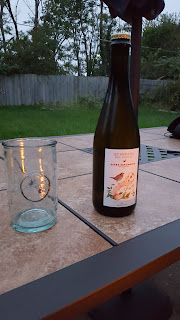Over the years of moving, traveling, going out to eat, and cooking at home, I ended up getting introduced to a variety of cuisines. I enjoy trying new foods and drinks, so it's been pretty fun. Among my favorite things to sample when I'm in a new place or see something unique on a menu or just at the grocery store, is often a beverage. I have to say beverage because I'm up for anything. I love beer. All styles. I love ciders. I love wines. Cocktails. Sodas. Tea. Coffee. You can find nuance and creativity in the breadth of drinks available in almost any area.
While spending time in Spain I ran across their version of cider. My wife has an aunt from Valladolid, which, for her southern family, qualifies as the north of Spain. Not everyone will agree with that, but it's definitely far enough north to enjoy a different selection of food and drink than you would commonly find in the south. On one Dia de los Reyes, while visiting her house, I saw her pouring a drink out of a bottle about head high while she stretched to put the glass down below her waist. She looked drunk. I couldn't figure out why anyone would be pouring something like that. I work in chemistry and have met some people that were fantastic at pouring liquids, but this was weird. I asked what she had and was told that it was "sidra" and that it needed to be poured that way for the drink to aerate properly. It's definitely tradition, I've learned, but I haven't done enough comparisons myself to determine if it changes the taste much. What I did learn that day, was that I love sidra.
I'll be calling Spanish cider "sidra" in this post (and maybe subsequent posts?) to save a word and to indicate that it's a little different than hard apple juice from other places. I might be being a snob, but I'm not trying to. I have read and heard sidra described as funky by different people, both reviewers and servers. I can remember getting a bottle of Isastegi (a nice Basque cider that I'd recommend if you haven't already tried it) at a "pub" in Durham, North Carolina and being warned that it was not a normal cider. Luckily I already knew. Sidra isn't normally sweetened or carbonated. It's closer to an apple wine if I'm not mistaken. I don't really know if there's anything special about the fermentation that gives it a funkiness, but I haven't read anything about bacteria being added to the process for that purpose. It does, however, get a pretty distinct flavor and ends up being pretty different from the cider selection at most American grocery stores.
Time to get to the point at hand, though: I have got a bottle of Chilean "sidra espumante" that I'm trying and I want to record it. I got the bottle from a wine shop in Columbia, Missouri where I was told that it was a Basque cider. I read that label and the guy then decided that his seller must have meant that it was made in the Basque style. Fine with me. I'm more than willing to give a cider from Chile a go. The bottle cost me about $15, so it's about what you might expect for imported alcohol. The bottle recommends enjoying the cider with pork chops or soft cheeses, so I naturally cooked chili today. Works for me.
Right off the bat, the cider pours with a head. Not a bad thing, and what I would want from a cider that calls itself "espumante" or foamy. I pour it into some recycled glass cups from Spain that some friends gave us a while back. Closest thing I have to a real cider glass. The first taste is effervescent, tart, and a little sweet. It has a good, crisp bite to it. The color is pale yellow. After a couple of swallows I can taste what seems like a Fuji apple as an aftertaste. I only poured small amounts at a time into the glass and I won't lie about smelling anything since we had a fire going outside while I was drinking this. Overall, the cider was good. Nothing incredibly complex, but a simple, "appley" drink with some carbonation that had a good, somewhat sweet taste and went down easily. I enjoyed it with the chili, but I'm not overly upset by pairing strange combinations together. I have mentioned that it's sweet, but I don't know that it has been sweetened beyond the normal sweetness that a cider produces. It certainly is a lower level of sweetness than what you would find in many grocery store ciders. The sweetness is probably closer to what you'd find from a "dry English-style" cider.
I think that the cider is worth recommending, and I can say that I wouldn't mind buying it again. Also, this is pretty fun and I think I might review more things on here.
